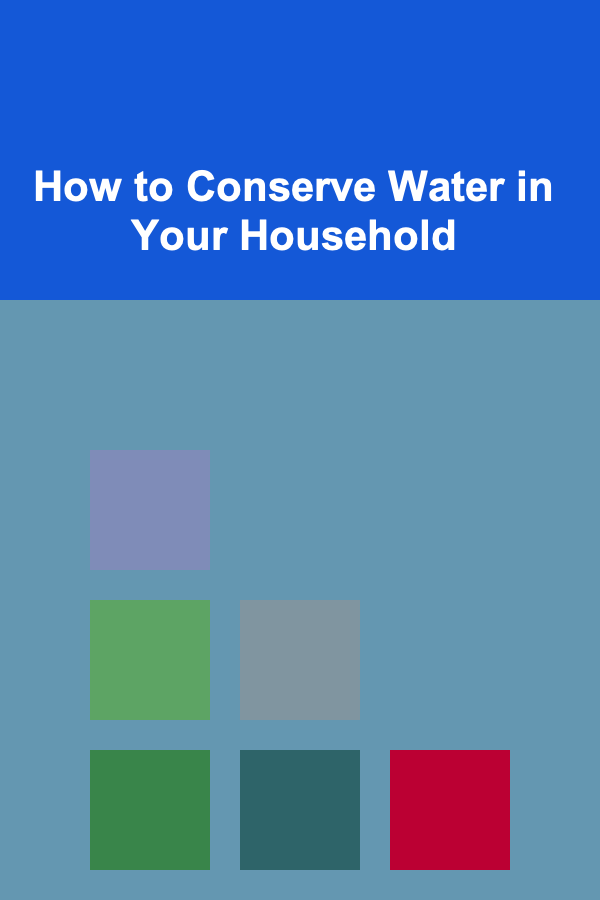
How to Conserve Water in Your Household
ebook include PDF & Audio bundle (Micro Guide)
$12.99$10.99
Limited Time Offer! Order within the next:

Water conservation is becoming increasingly important as the global population grows and the planet faces environmental challenges. For many years, water was considered an infinite resource, but today, we are seeing water scarcity in many parts of the world. Households consume a significant portion of the world's water supply, which means individual actions can make a substantial impact on conserving water.
In this article, we will explore how to conserve water in your household, focusing on both small and large changes that can make a difference. From everyday habits to home upgrades, there are many practical solutions that you can implement to reduce your water usage while contributing to a more sustainable future.
Why Water Conservation Matters
Water is essential for all forms of life, and its availability is crucial for maintaining ecosystems, agriculture, and human health. However, despite its importance, water is not distributed evenly across the planet. Many regions face water scarcity due to factors such as over-extraction, climate change, and pollution.
As populations grow, the demand for water increases, and the supply often doesn't keep up with demand. In fact, over 2 billion people currently live in water-stressed regions, and many communities face the challenge of accessing clean, safe drinking water. The effects of climate change are also exacerbating the issue, causing droughts, changing rainfall patterns, and decreasing water quality.
Conserving water is one of the most impactful ways to address these challenges. By reducing water consumption, individuals can help reduce the strain on freshwater resources, save money on water bills, and contribute to environmental sustainability.
Ways to Conserve Water in Your Household
1. Fix Leaks Promptly
One of the easiest and most effective ways to conserve water is by fixing leaks in your plumbing. A small, undetected leak in your faucet or toilet can waste hundreds of gallons of water each year. According to the U.S. Environmental Protection Agency (EPA), a dripping faucet can waste up to 3,000 gallons of water annually. Similarly, a leaking toilet can waste as much as 200 gallons of water per day.
To avoid unnecessary water wastage, regularly check your faucets, toilets, and pipes for leaks. If you notice any leaks, take immediate action to repair them. In many cases, fixing leaks is a simple and inexpensive task that can be done with basic plumbing skills or by hiring a professional plumber.
2. Install Water-Efficient Appliances
Upgrading your appliances is an effective way to conserve water. Modern washing machines, dishwashers, and toilets are designed to use less water than older models. For example, a high-efficiency washing machine can use up to 50% less water than older models, while a low-flow toilet uses significantly less water per flush.
Consider replacing old appliances with water-efficient models. Look for the EPA's WaterSense label, which indicates that the appliance meets water efficiency standards. These upgrades may have an initial cost but will save you money in the long term by reducing water usage and lowering utility bills.
3. Use Low-Flow Fixtures
Another simple way to conserve water in your home is by installing low-flow fixtures in areas where water is frequently used, such as the bathroom and kitchen. Low-flow showerheads, faucets, and aerators reduce water flow without compromising water pressure.
For example, a low-flow showerhead uses about 2.5 gallons of water per minute, compared to the 5 gallons used by a standard showerhead. Similarly, low-flow faucets and aerators can reduce water usage by up to 30%. These small changes can add up to significant water savings over time.
4. Take Shorter Showers
Showering is one of the biggest water-consuming activities in most households. The average shower uses about 2.1 gallons of water per minute, meaning a 10-minute shower consumes more than 20 gallons of water. If you're not careful, taking long showers can quickly add up.
To reduce water consumption, try to shorten your shower time. Aim for 5-7 minutes instead of 10 or more. You can also use a timer or a shower clock to track your time and remind you to turn off the water when you're done. Additionally, consider turning off the water while lathering up or shaving to avoid wasting water unnecessarily.
5. Run Full Loads in the Dishwasher and Washing Machine
When doing laundry or dishes, always try to run full loads. Running your washing machine or dishwasher with a half-empty load wastes both water and energy. By waiting until you have a full load of laundry or dishes, you can make the most of each wash cycle, reducing the frequency of use and saving water in the long run.
If you need to do smaller loads, consider using a machine's "eco" or "half-load" setting, if available. These settings are designed to use less water and energy while still cleaning effectively.
6. Turn Off the Tap When Not in Use
Many people are guilty of leaving the water running when it's not needed. Whether you're brushing your teeth, washing your hands, or doing dishes, turning off the tap when you're not actively using water can save gallons each day.
For example, leaving the faucet running while brushing your teeth can waste up to 4 gallons of water per minute. Similarly, running the tap while washing dishes can add up to a lot of wasted water. Make it a habit to turn off the faucet whenever you're not using it, and you'll see a noticeable reduction in your water consumption.
7. Water Your Garden Wisely
Outdoor water usage, particularly for gardening and lawn maintenance, accounts for a significant portion of household water consumption. While it's important to keep your garden and lawn healthy, there are ways to water more efficiently.
Consider watering your garden early in the morning or late in the evening when temperatures are cooler, and the water is less likely to evaporate. You can also use a soaker hose or drip irrigation system, which delivers water directly to the roots of plants, minimizing waste. Avoid using sprinklers, which often water areas that don't need it, such as sidewalks or driveways.
Additionally, choose drought-resistant plants that require less water and replace traditional grass lawns with xeriscaping, which uses minimal water and reduces the need for irrigation.
8. Install a Rainwater Harvesting System
Rainwater harvesting is an environmentally friendly way to conserve water and reduce your reliance on municipal water supplies. By collecting rainwater from your roof, you can store it for use in your garden, lawn, or even for cleaning purposes.
Installing a rainwater harvesting system typically involves setting up gutters, downspouts, and storage tanks to collect and store rainwater. This water can then be used for non-potable purposes, such as irrigation, reducing the amount of freshwater needed for outdoor tasks.
9. Use a Pool Cover
If you have a swimming pool, a pool cover can help conserve water by preventing evaporation. Pools lose a significant amount of water to evaporation, especially during hot weather. A pool cover can reduce this loss, keeping your pool water levels stable and reducing the need for frequent refilling.
In addition to conserving water, pool covers can also help maintain the temperature of the water, reduce chemical usage, and minimize debris in the pool, making maintenance easier.
10. Educate Your Family and Household Members
Water conservation is a team effort. To make a real difference, everyone in your household should be on board with the goal of using less water. Educate your family members about the importance of water conservation and encourage them to adopt water-saving habits.
Make it a family challenge to reduce water usage, and reward everyone for their efforts. Setting up reminders around the house, such as stickers on faucets or showerheads, can also help reinforce the message.
Conclusion
Water conservation is not just a trend but a necessary practice for preserving our planet's limited resources. By making small changes to our daily routines, we can significantly reduce water consumption and minimize the impact of our households on the environment.
From fixing leaks to upgrading appliances, installing low-flow fixtures, and adopting mindful water-use habits, there are numerous ways to conserve water in your home. Every action counts, and collectively, these efforts can help ensure that future generations will have access to clean and sufficient water.
Start today by implementing some of these strategies, and encourage your family and friends to join you in the effort. Together, we can all play a role in protecting this precious resource and creating a more sustainable future for all.

Effective DIY Cost-Cutting Ideas for Every Homeowner
Read More
How to Use Mulch for Both Organization and Aesthetics
Read More
The Art of Synthesizing Information: Mastering Research Methods for Effective Decision Making in a Research Analyst Role
Read More
The Video Editor's Toolkit: Proven Methods for Perfecting Your Craft and Delivering Professional Results
Read More
How to Conquer Your Fear of Heights for Adventure
Read More
How to Organize Your Errands by Location & Time
Read MoreOther Products

Effective DIY Cost-Cutting Ideas for Every Homeowner
Read More
How to Use Mulch for Both Organization and Aesthetics
Read More
The Art of Synthesizing Information: Mastering Research Methods for Effective Decision Making in a Research Analyst Role
Read More
The Video Editor's Toolkit: Proven Methods for Perfecting Your Craft and Delivering Professional Results
Read More
How to Conquer Your Fear of Heights for Adventure
Read More